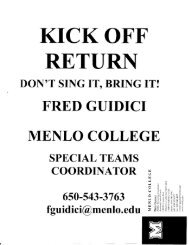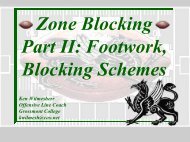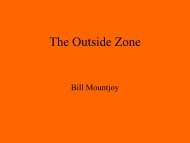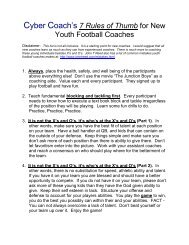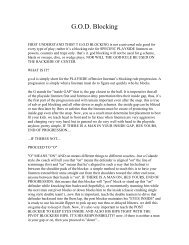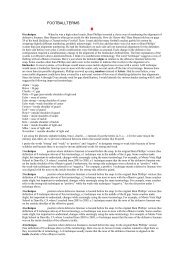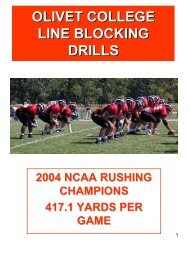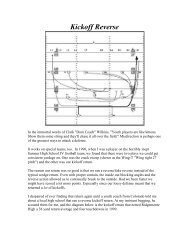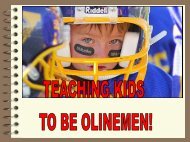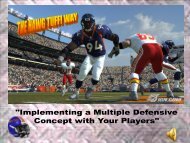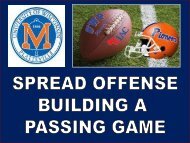cool_clinic_notes.21.. - Hawg Tuff
cool_clinic_notes.21.. - Hawg Tuff
cool_clinic_notes.21.. - Hawg Tuff
You also want an ePaper? Increase the reach of your titles
YUMPU automatically turns print PDFs into web optimized ePapers that Google loves.
2011 Offensive Line<br />
Coaches Handbook<br />
Featuring Lectures From the 2011 C.O.O.L. Clinic<br />
Featuring presentations made by several of America’s most outstanding coaches, including Bob Bostad, Paul Boudreau,<br />
James Campen, Jeff Grimes, John Hevesy, Sean Kugler, Jim McNally, Sam Pittman, George Warhop, and Tony Wise.<br />
A Brief History of the C.O.O.L. Clinic<br />
The concept of a <strong>clinic</strong> geared specifically toward addressing the needs and interests of offensive linemen came to<br />
fruition in 1982, when a group of about 18 coaches met with Jim McNally, an assistant coach with the NFL’s Cincinnati<br />
Bengals, in the Bengals’ training facility. This situation continued for a few years, before the <strong>clinic</strong> eventually became<br />
too big for the Bengals’ facilities. In response, McNally moved the <strong>clinic</strong> to a hotel in Cincinnati in the mid-1980s.<br />
Among coaches at the initial meeting were Bob Wylie and Paul Alexander, both of whom were to remain involved with<br />
C.O.O.L. Clinic over the years.<br />
In 1995, McNally left the Bengals for a position on the staff of the Carolina Panthers. Bob Wylie, whom McNally had<br />
asked to be the caretaker of the <strong>clinic</strong>, then conducted the <strong>clinic</strong> for one year in Tampa, Florida. Upon being hired by<br />
the University of Cincinnati, Wylie brought the <strong>clinic</strong> back home to Cincinnati in 1996.<br />
Since that time, the C.O.O.L. Clinic has been at the same hotel in Cincinnati, although it has changed names over the<br />
years from the Clarion Hotel, to the Regal Hotel, to the present-day Millennium Hotel. Traditionally, the C.O.O.L. Clinic<br />
has been held the third week in May each year to accommodate the large number of college coaches who incorporate<br />
this event into their spring schedule.<br />
About the Mushroom Society<br />
The Mushroom Society was established by a group of professional offensive line coaches. The mushroom<br />
logo signifies the similarity between the “O-line” coach and the fungus—both are kept in the dark and fed<br />
garbage, yet continue to flourish! C.O.O.L. (Coaches of Offensive Linemen) are proud to be mushrooms.<br />
A SPECIAL TRIBUTE TO PAUL BOUDREAU—A FOOTBALL LEGEND<br />
Paul Boudreau has been the offensive line coach for the Atlanta Falcons since 2008.<br />
Boudreau has coached in the NFL since 1987, including stays with the St. Louis Rams<br />
(2006-07), Jacksonville Jaguars (2003-05), Carolina Panthers (2001-02), Miami Dolphins<br />
(1999-2000), New England Patriots (1997-98), Detroit Lions (1994-96), and New Orleans<br />
Saints (1987-93). Prior to coaching in the NFL, Boudreau served as a college coach,<br />
including stays at the United States Naval Academy (1982), Dartmouth (1979-81), The<br />
University of Maine (1976-78), and Boston College (1974-75). A native of Arlington, MA,<br />
Boudreau was an offensive lineman at Boston College (1971-73). Boudreau and his wife,<br />
Joan, have two children, Paul and Jill.<br />
Paul Boudreau<br />
ISBN 978-1-60679-179-0<br />
5 1 9 9 5<br />
9 781606 791790<br />
US $19.95<br />
Browning<br />
2011 Offensive Line Coaches Handbook Coaches Choice
2011<br />
OFFENSIVE LINE<br />
COACHES<br />
HANDBOOK<br />
FEATURING LECTURES FROM<br />
THE 2011 C.O.O.L. CLINIC<br />
Edited by Earl Browning<br />
www.coacheschoice.com
© 2010 Coaches Choice. All rights reserved. Printed in the United States.<br />
No part of this book may be reproduced, stored in a retrieval system, or transmitted, in any<br />
form or by any means, electronic, mechanical, photocopying, recording, or otherwise, without<br />
the prior permission of Coaches Choice.<br />
ISBN: 978-1-60679-179-0<br />
ISSN: 1945-1172<br />
Telecoach, Inc. Transcription: Emmerson Browning, Kent Browning, and Tom Cheaney<br />
Diagrams: John Rice<br />
Book layout: Bean Creek Studio<br />
Cover design: Bean Creek Studio<br />
Front cover photo: US PRESSWIRE<br />
Back cover photo: Bob Donnan—US PRESSWIRE<br />
Special thanks to John Widecan of the University of Cincinnati for taping the lectures.<br />
Coaches Choice<br />
P.O. Box 1828<br />
Monterey, CA 93942<br />
www.coacheschoice.com<br />
2
Contents<br />
Speaker Team Topic Page<br />
Bob Bostad University of Wisconsin Wisconsin’s Perimeter Run Game ......................................5<br />
Paul Boudreau Atlanta Falcons Tying the Run-Action Pass Game and<br />
Run Game Together ............................................................... 10<br />
James Campen Green Bay Packers Practice Organization and<br />
Offensive Linemen Fundamentals ................................... 23<br />
Jeff Grimes Auburn University The Openside Gap Scheme Run Game ............................. 41<br />
John Hevesy Mississippi State University Counter Run Game and Play-Action Pass ..................... 46<br />
Sean Kugler Pittsburgh Steelers Gap Scheme and Keys to Film Study for<br />
Offensive Linemen ................................................................ 52<br />
Jim McNally NFL Consultant and Footwork .................................................................................. 69<br />
Former NFL Coach<br />
Sam Pittman University of North Carolina Ways to Get the Ball Outside ........................................... 78<br />
George Warhop Cleveland Browns The Perimeter Run Game .................................................... 83<br />
Tony Wise Retired NFL Line Coach How to Coach the Power Play<br />
From the Tight End Side ...................................................... 94<br />
Question & Answer Session ..................................................................................................................................................107<br />
About the Clinic Director .......................................................................................................................................................... 111<br />
About the Editor ...........................................................................................................................................................................112<br />
3
Thank you. It is my great pleasure to be here. I still<br />
learn so much by coming to this <strong>clinic</strong>. It is really<br />
great to speak with you today.<br />
We are primarily a power team and an inside<br />
zone team. As a third play, we are a pin-and-pull<br />
team. We use these three concepts. I want to talk<br />
primarily today about the pin-and-pull scheme. We<br />
have five different plays within this scheme. The<br />
reason we run this offense is because of the inside<br />
zone, and the power is designed against the same<br />
type of teams. The system is designed to allow us<br />
to attack the defense where we are outnumbered.<br />
We are going to be outnumbered a lot of times.<br />
We do not have a quarterback who can run out of<br />
sight in a day. We are a traditional, offensive-style<br />
football team. We have to look at the advantages<br />
and disadvantages of running this scheme.<br />
Advantages<br />
• Efficiency<br />
• YPC explosiveness<br />
• Complements run menu<br />
• Every down run pressure<br />
• Broadens your attack<br />
This year, one fifth (or 20 percent) of the plays<br />
we ran from this scheme were explosive plays. We<br />
consider explosive plays to be a gain of 12 or more<br />
yards per carry. It complements our run menu. As<br />
I said before, we are primarily an off-tackle power<br />
team and an inside zone team. We can run part<br />
of our offense out of every formation, and with<br />
our best personnel that we start the game with.<br />
Certain movements or pressures may give us some<br />
issues, but we can adjust. I believe this type of<br />
scheme complements our power and inside zone<br />
attack. Really, you are working to the same guy,<br />
whether it is inside zone or outside zone, but you<br />
change the angle a little. You still have the same<br />
Bob Bostad<br />
Wisconsin’s Perimeter run GAme<br />
university of Wisconsin<br />
5<br />
problems, though, in my opinion. This puts a little<br />
more pressure on the defense.<br />
This play has been a good play for us, on every<br />
down. We run it on first and second down, but it is<br />
a great change-up for us on third down. It is also a<br />
great pressure run play. Every defense wants to<br />
run their zone blitz pressure package at you. When<br />
you have your tackle pulling on their outside safety,<br />
and you have everyone blocked on that side, you<br />
have the defense in a real bind. So it is good versus<br />
pressure, and you have some answers against the<br />
defense. More than anything else, you have a plan.<br />
It broadens your attack.<br />
Disadvantages<br />
• Rules/assignments<br />
• Match-ups<br />
• Edge blockers tight end<br />
Some rules are very easy and stay consistent.<br />
Sometimes, they can get a bit cloudy, specifically<br />
when you are pulling people. Not everybody wants<br />
to pull guys. They may feel that they are not athletic<br />
enough to pull linemen and get the job done.<br />
Match-ups can be difficult. You might have a<br />
tackle pulling on the safety, which is great if they<br />
fit, but sometimes that is not a good match-up.<br />
Sometimes, the defensive back is a pretty good<br />
athlete and can get around that lineman, who may<br />
not be as mobile.<br />
We play a lot of two tight ends formations. We<br />
are asking those guys to set the edge for us. That<br />
is a huge undertaking for them. We play with some<br />
undersized tight ends. Sometimes, those smaller<br />
tight ends still match up well. They set the edge<br />
that you want.<br />
Let’s go through the play. Obviously, you are<br />
going to teach all of the aspects of this play, if
you elect to run it. You are going to tell them to do<br />
it the way you teach them to do it and in the way<br />
you want to develop. Let’s just start from the<br />
beginning.<br />
We just call the play “flex.” Our quarterback is<br />
going to open up at 4:30 or 7:30 with his footwork,<br />
depending on which side he is going to. He will naked<br />
fake away from the play. He is not in a rush on the<br />
fake, and he will not be leaning to make the handoff.<br />
Our tailback lines up with his heels at seven yards.<br />
Everything matches, whether it is power play<br />
or inside zone play. His footwork is to open with<br />
his playside foot. His landmark is one by one yard<br />
outside of the tight end. His run will be at the tight<br />
end. He wants to read the block of the tight end.<br />
We run it with one tight end, and sometimes with<br />
two tight ends. The quarterback is going to learn<br />
through repetition.<br />
Another big thing for the tailback is to key the<br />
second puller. We are a big second puller–type<br />
team. I want to win the real estate battle right<br />
away. The closest guy to get there will be the<br />
playside tackle. We want our guards to be the<br />
muscle guys who can handle the inside running<br />
game. Our second puller is going to be the center. As<br />
far as athleticism is concerned, he is just underneath<br />
our tackles. He needs to be just as fleet of foot as<br />
our tackles. The running back must find the point of<br />
entry (Diagram #1).<br />
C<br />
S S<br />
B<br />
E<br />
B B<br />
C<br />
T<br />
Diagram #1. Flex—tackle and center Pull<br />
I want to emphasize a coaching point here. The<br />
quarterback and the tailback are not in any hurry.<br />
The running back’s first step is going to mirror the<br />
T<br />
E<br />
6<br />
same steps as an inside zone play. The difference<br />
will be on the second step, where the shoulders of<br />
the running back are really opening up and squaring<br />
up. By that time, things are done. The running back<br />
reads the pulling center’s block and makes his cut<br />
off that block.<br />
As far as the receivers are concerned, we will<br />
never compromise. The receivers are always going<br />
to block a corner or safety, and nothing more or<br />
nothing less. We will not have a match-up with a<br />
wide receiver on a linebacker, because that is not<br />
a good match-up for us. We make it easy for the<br />
receivers group. They only have to block someone<br />
their own size, and we keep it simple. If I am blocking<br />
as an X- or a Y-receiver, I am going to block the man<br />
over me. If I am a slot receiver, I will not block the<br />
linebacker that is in my general area. We make him<br />
move up a level to the safety because we do not<br />
like the match-up with the linebacker.<br />
If you are on the playside, you are blocking the<br />
man on you. If you are on the backside, you are going<br />
to count one to two. The number-one guy is the man<br />
on you. You are going to go to the next defensive<br />
back to your inside, and block that defender. A lot<br />
of receivers have a tendency to hop prior to their<br />
first step. By the time they come down on the hop,<br />
the play is already going, and people are moving<br />
everywhere. I coach them to take a directional lead<br />
step pointed on their angle of departure, right at<br />
that #2 defender. I want them to gain ground and<br />
get their body physically going in that direction<br />
immediately. The closer to the line of scrimmage<br />
the second defender is, the flatter the angle he has<br />
to take.<br />
We want to get our face masks to the playside<br />
number with our linemen. Obviously, the defenders<br />
are going to fight for containment, but we have to<br />
fight to get around him. If we get the edge, we will<br />
have a pretty good play.<br />
The playside tight end has a reach block.<br />
Philosophically, I want the tight end to have the<br />
very best angle on his block. We want the tight end<br />
blocking down on the 5, 6, or 7 technique. We do not<br />
want to create a bunch of different issues here. We<br />
want to keep it simple. The tight end blocks down<br />
and the tackle pulls. We call that a Ted block.
When we game plan this play, we look for the<br />
soft edge. We do not run this against 9 techniques,<br />
if we can help it. If you are getting a lot of 6<br />
techniques, and a lot of 9 techniques, the defense<br />
does not believe you can run the ball on the inside.<br />
Make sure you are getting situations where you are<br />
running to the open area and to the soft edges. If<br />
you ask the tight end to block the 9 technique, that<br />
is a hard way to make a living.<br />
If we motion the tight end over against a 9<br />
technique, we do not want him to take a large split<br />
from the tackle. We want our normal one-and-a<br />
half-foot split. We do not want to create any extra<br />
real estate issues that he has to negotiate. We<br />
are going to reach the 9-technique end with a flat<br />
first step to the playside, and the second step is to<br />
his crotch. I want to go with the face mask to the<br />
playside number, and then I want to work through<br />
that number. I want to be on it right now. I want to<br />
get the edge right now.<br />
Our playside tackle needs to be our best athlete.<br />
We want him to pull 99.9 percent of the time. He is<br />
going to pull to the first force defender. This is<br />
where you get into a gray area because that could<br />
be anybody. He still block the first force defender<br />
no matter who it is. The aiming point is inside foot<br />
to inside foot, with his hat across the defender.<br />
What that does is to cover up the defender. We do<br />
not want to be on edges, and we do not want to be<br />
overextended on the outside half, or underextended<br />
on the inside half. In the past, we have had a lot of<br />
defenses try to cut our puller. Our response to that<br />
was to cut their cutter.<br />
I need to make a coaching point here. You must<br />
pre-snap read the pulling area. Your players have to<br />
have a bit of wherewithal and understand where<br />
the ball is going. They need to know where the<br />
receivers are and if we are going to an openside, or<br />
if we are going to a two-receiver side. That will help<br />
them understand who the first force defender will<br />
be. If a defensive back is standing there alone, he is<br />
most likely going to be the first force defender.<br />
We had 170 pin-and-pull scheme plays this year.<br />
I break them down into first pullers and second<br />
pullers. I track the pulls by the number of steps and<br />
measure them. When you coach it that way, it is<br />
7<br />
a great way to make sure your kids are practicing<br />
what they do on the game field. The #1 puller is<br />
at five steps before he hits the contain or spill<br />
guy. You are going to be most effective if you are<br />
stepping with your fifth step, which is an outside<br />
foot. You either take the defender wide, or stop him<br />
and stay square to protect the path of the running<br />
back. He cannot allow the defender to get a quick<br />
underneath tackle.<br />
The second puller is a four-step take. He is<br />
stepping one, two, three, and on four, he is making<br />
contact with the defender, and he is driving his man.<br />
This is when he is going to be the most effective and<br />
the most powerful. If it is not on the fourth step, it<br />
is a little bit of a gray area. You want to make it as<br />
simple and clear as you can for that running back.<br />
Everything is about making it good for the running<br />
back.<br />
We reach block with the playside guard. Our<br />
guards are going to get good at reaching because<br />
90 percent of the time, they are not going to pull.<br />
It does not matter if it is a 1, 2, or 3 technique; the<br />
aiming point is the same: face mask to the playside<br />
number.<br />
We do not get real technical. You may step a<br />
little differently for each alignment, but your aiming<br />
point is still face mask to the playside number. One<br />
thing he needs to understand is the closer he gets<br />
to the center, he does not have to protect the path<br />
as much. The only time that they would change is if<br />
we get a 4i look. If that happens, the tackle blocks<br />
down, and the guard is the first force defender.<br />
The guard has to reach the 3 technique. I want<br />
to get the face mask to the playside number right<br />
away. We are not going to work through it. My off<br />
hand is in the breastplate, and I want to punch that<br />
guy in the chest. I do not want to set it in there.<br />
It is a punch. The second hand is going to be our<br />
cheat hand. We try to get it on the upper arm of the<br />
defender, and we are going to drive through on the<br />
aiming point.<br />
The center has to make a call to determine<br />
who is going to pull, either the center or the guard<br />
(Diagram #2). We make him declare. The key is who<br />
is covered and who is uncovered. If I am uncovered,<br />
I am pulling. Generally, the center is pulling and is
C<br />
S<br />
B<br />
E<br />
Diagram #2. Flex—tackle and Guard Pull<br />
blocking the Mike linebacker or the inside linebacker.<br />
If the center is covered, he is going to reach the<br />
defender, and he is going to bring the backside<br />
with him. However, those things can change. If the<br />
second puller is pulling, he has to watch and protect<br />
against frontside run-throughs.<br />
We are an open pull team. We do not teach<br />
skip pulls. We open pull, and we try to accelerate<br />
and get out there as fast as we humanly can. The<br />
second puller has to find his point of entry. The<br />
center will have about nine steps into the D gap and<br />
contain area. That is what we use to try to simulate<br />
what he is going to see in a game. We want to have<br />
some type of muscle memory that he can carry<br />
over to when we are playing a game.<br />
This is the only way we can get out on the<br />
play unless we are going to play the tackle run all<br />
day. They have plenty of guys for us. They have us<br />
outnumbered almost every time. This is the only<br />
way we can get out and even up the numbers.<br />
The backside is about intersecting angles. It<br />
is really simple. It is about going as fast as you<br />
humanly can and getting to the backside A-gap<br />
or B-gap linebacker. We do not want to wait for<br />
anyone. We do not want to say it is Mike, Will, or<br />
anybody else. We want to get the linebacker who<br />
is in the A or B gap. The backside tackle also takes<br />
an intercept angle. He does not wait on anyone. As<br />
he sees things develop, he keeps climbing to find<br />
somebody to block downfield.<br />
T<br />
Thanks a lot, guys. I really appreciate your time.<br />
S<br />
B B<br />
C<br />
T<br />
E<br />
8<br />
ABout the Author<br />
Bob Bostad is in his fifth season as an assistant<br />
coach at the University of Wisconsin at Madison.<br />
He was named run game coordinator in February of<br />
2007 and became the Badgers’ offensive line coach<br />
in January 2008 after coaching tight ends his first<br />
two seasons. The 2010 season proved to be one<br />
of the most successful in school history, thanks in<br />
large part to the efforts of the offensive line.<br />
Averaging 245.7 rushing yards per game,<br />
Wisconsin finished 12th in the country. The Badgers<br />
nearly made history as they fell just four yards<br />
short of having three running backs run for at least<br />
1,000 yards in the same season. No team in FBS<br />
history has ever done that.<br />
The Wisconsin offense shattered the school<br />
record for scoring average, leading the Big Ten and<br />
finishing fifth in the country with 41.5 points per<br />
game. The Badgers also tied a Big Ten record with<br />
46 rushing touchdowns and set a school record by<br />
averaging 5.47 yards per carry.<br />
Bostad also oversaw the development of a pair<br />
of All-Americans. Gabe Carimi, the 2010 Outland<br />
Trophy winner, was a consensus All-American,<br />
while John Moffitt was first-team All-American by<br />
the Associated Press.<br />
Wisconsin is one of just five teams in the<br />
country that has averaged at least 200 yards rushing<br />
per game in each of the last four seasons. Last<br />
year, despite starting six different combinations at<br />
offensive line, UW led the Big Ten in total offense,<br />
scoring offense, and rushing offense, while<br />
allowing just 23 quarterback sacks, its lowest total<br />
since 2004. Running back John Clay earned Big Ten<br />
Offensive Player of the Year honors while leading<br />
the Big Ten and ranking eighth in the country with<br />
1,517 rushing yards. Two offensive linemen, tackle<br />
Gabe Carimi and center/guard John Moffitt, were<br />
named first-team All-Big Ten.<br />
In 2008, Bostad helped guide a running game that<br />
averaged a Big Ten–leading 211.2 yards per game,<br />
good for 14th in the country. Running backs P.J. Hill<br />
and Clay combined for 2,045 yards and became the<br />
first Badger duo to run for at least 800 yards in the<br />
same season since 1994. Hill cracked the 1,000-yard



